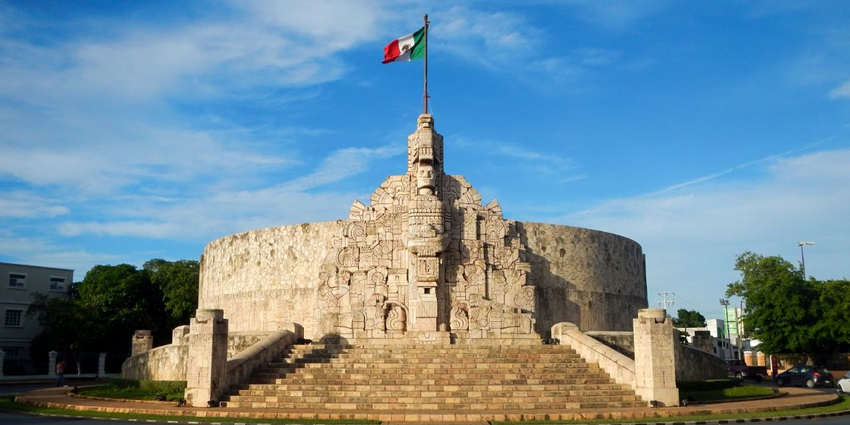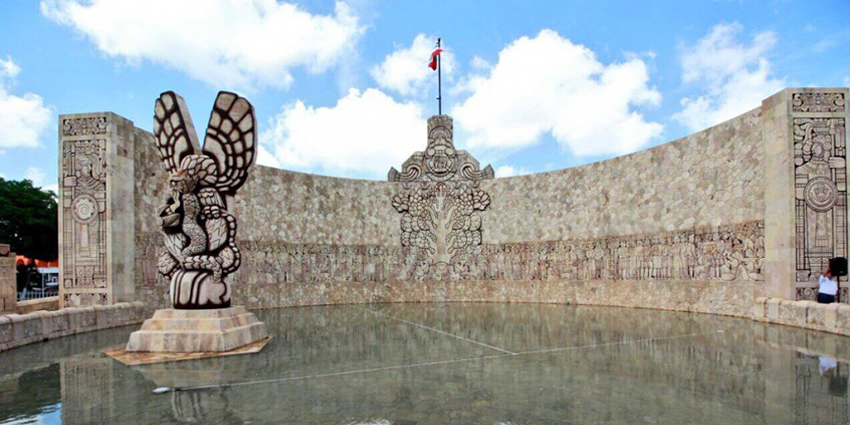
Monument a la Patria, the iconic monument of Mérida
Monumento a la Patria (“Monument to the Homeland”) in Mérida is a stone monument erected in the mid-20th century to honor the Mexican homeland, sculpted entirely by hand by Colombian sculptor Rómulo Rozo.
Rómulo Rozo once expressed he had raised the first altar to the homeland in Mérida to erase from the national spirit the ideas about Yucatecan separatism. The monument belongs to everyone and for everyone.
Monumento a la Patria (“Monument to the Homeland”), located on Paseo de Montejo Avenue, is one of the most iconic structures in Merida and the only one in the world to be entirely carved directly out of stone.
Construction of the monument started on March 7, 1945, by the Colombian sculptor Romulo Roso in collaboration with the architect Manuel Amabilis Domínguez, his son Max Amabilis, and master builder Victor Nazario Ojeda.
Originally, the Monumento a la Patria was going to be dedicated solely to the Mexican flag.
But later it was decided that the monument would graphically represent the history of Mexico in the most complete way possible, making it one of the few structures in the country to fulfill that purpose.
Due to the complexity of the work, the construction lasted 11 years from the beginning of its construction until it was finally finished in 1956 and inaugurated on April 23 of that same year by the then-president of Mexico Adolfo Ruiz Cortines.
In 2016, the International Bureau of Cultural Capitals chose the Monumento a la Patria (“Monument to the Homeland”) as one of the Cultural Treasures of Mérida and as part of the cultural emblems of humanity.
The monument exhibits more than 300 hand-carved figures that reflect the history of Mexico from the founding of Tenochtitlán to the most important events in Mexican history in the first half of the 20th century, and even some American events and characters.
The monolith has a Neo-Maya indigenous deco architectural style and was entirely hand-carved in quarry stone. It consists of a central hemicycle with two ramps, a staircase, and a fountain.

The monument measures 14 m in height and 40 m in diameter with an area of 2,500 sq m.
On the front, there is a female figure in a genuflecting position with mestizo features.
The figure is wearing Mayan clothing and a jade necklace in the shape of a snail that hangs from her pectoral, covered with a chain mail decorated with feathered serpents next to a pendant that means the marine origin of the Itzá people.
The hands of the figure are adorned with bracelets that hold a standard bearer hoisting the Mexican flag. On both sides of the head, there are two fantastic figures half bird and half fish, representing sovereignty over the territorial seas and skies.
Below is the shield of Mérida and a typical Mayan hut inside which there is a lamp in which the votive flame of the Mexican homeland burns, surrounded by various Mayan symbols such as jaguars, Chac Mol, snails, rattlesnakes, as well as 2 armed and prostrate tiger knights, representing the dedication and protection of the Mexican armed forces.
Around the image, there is an allegory of offerings that represent the fruits of the earth, and the product of the work of the artists in the hands of 12 deities, which represent the trades and fine arts of the pre-Hispanic world.
On the façade of the monument facing north, in the lower concave part, there is a reflecting pool with a stone parapet that symbolizes Lake Texcoco, in which there is a reproduction of the events that gave rise to the national emblem: an eagle devouring a snake perched on a nopal, symbol of the founding of Tenochtitlán, both with Mayan motifs, with two columns on each side in which there are pre-Columbian stone warriors ready to fight for the homeland.
In the center, a ceiba is observed in the amphora, a sacred tree of the Mayans who believed that its branches reached the sky and its roots had a connection to the underworld, with 4 butterflies sculpted on top.
On the right side of the ceiba, you can see plastic scenes from the ancient civilization such as women dancing, men playing musical instruments, animals such as tapirs and deer, and the beginnings of the history of Mexico from the father of miscegenation, Gonzalo Guerrero, passing the stage of Christopher Columbus with his 3 caravels, the Pinzón brothers, the discoverer of Yucatán in 1517 Francisco Hernández de Córdoba until reaching the friar Bartolomé de las Casas, defender of the indigenous people.
On the left side there are images of indigenous people with offerings and dancing, the image of Cuauhtémoc and the astronomer Francisco Javier. Throughout this face of the monument, various passages of the country’s life are narrated, such as the independence of Mexico and its emblematic characters; the Reform of Juárez and the fight of the Children Heroes against foreign intervention, and Porfirio Díaz who would eventually become dictator.
Characters of the Mexican Revolution such as Francisco I. Madero, Emiliano Zapata, and Pancho Villa are also depicted, as well as various events that led Mexico to a state of ‘modernity’ at the beginning of the second half of the 20th century.
A parapet closes the fountain that symbolizes Lake Texcoco in which 31 small columns stand out, corresponding to the 31 states of the Republic and Mexico City, a symbol of the unity of the Mexicans.
Let us know if this article was useful for you